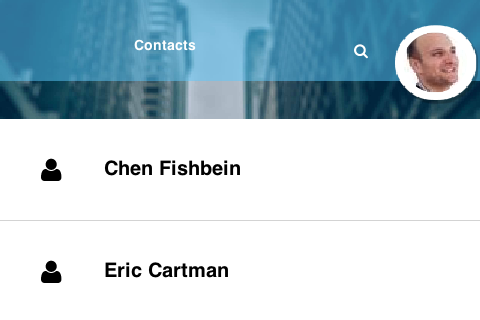
This tutorial is starting to get interesting…. In this section we’ll go deep into animations, special effects, search
styling and extracting contacts. In the previous sections we built the first form of the app, logged in and now we
need to show the actual login form. Even more importantly we need to show it with style like this:
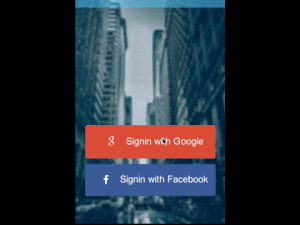
(notice that you should see an animated gif above naturally we reduced quality to make it smaller but it still takes
a moment to load).
What we see here is how the login form animates out by sliding out the buttons to the right then morphing the background
into the title area of the following form. We’ll get into how this is done soon enough… But first lets get the contact details!
New Contacts API
First we need to add contact access permissions to the Google API by adding the line
‘gc.setScope(“profile email https://www.googleapis.com/auth/plus.login https://www.googleapis.com/auth/plus.me”);’
into the initial login as such:
loginWithGoogle.addActionListener((e) -> {
tokenPrefix = "google";
Login gc = GoogleConnect.getInstance();
gc.setScope("profile email https://www.googleapis.com/auth/plus.login https://www.googleapis.com/auth/plus.me");
gc.setClientId("1013232201263-lf4aib14r7g6mln58v1e36ibhktd79db.apps.googleusercontent.com");
gc.setRedirectURI("https://www.codenameone.com/oauth2callback");
gc.setClientSecret("uvu03IXOhx9sO8iPcmDfuX3R");
doLogin(gc, new GoogleData());
});We are effectively asking for more permissions. Notice that profile and email are shorthand syntax for the full URI
accepted by Google and the values in the scope are separated by a space.
To make contacts access generic we changed a few things in the interfaces defined in the previous steps:
static class ContactData {
public String uniqueId;
public String name;
public String imageUrl;
}First we added the simple contact data abstract class to represent a specific contact. Normally, we would just use
something simpler but since Google & Facebook have radically different image sources we had to create two
different implementations of this class.
static interface UserData {
public String getName();
public String getId();
public String getImage();
public void fetchData(String token, Runnable callback);
public ContactData[] getContacts();
}We only added one method to user data, the getContacts method. For simplicity we fetch all the contacts and do
so synchronously. In a future iteration we might improve this by creating an implementation that “streams” the contacts
but for now we wanted something simple that will also lend itself well to search.
Getting The Contacts On Google
We connect to the Google webservice and get all visible contacts. Here we don’t have to limit ourselves to people
who installed the app and this gives us more information:
private String token;
@Override
public ContactData[] getContacts() {
ArrayList<ContactData> dat = new ArrayList<>();
ConnectionRequest req = new ConnectionRequest() {
@Override
protected void readResponse(InputStream input) throws IOException {
JSONParser parser = new JSONParser();
Map<String, Object> parsed = parser.parseJSON(new InputStreamReader(input, "UTF-8"));
java.util.List<Object> data = (java.util.List<Object>)parsed.get("items");
for(Object current : data) {
Map<String, Object> cMap = (Map<String, Object>)current;
String name = (String)cMap.get("displayName");
if(name == null) {
continue;
}
String type =(String)cMap.get("objectType");
if(!type.equals("person")) {
continue;
}
String id = cMap.get("id").toString();
ContactData cd = new ContactData();
cd.name = name;
cd.uniqueId = id;
if(cMap.containsKey("image")) {
cd.imageUrl = (String)((Map<String, Object>)cMap.get("image")).get("url");;
}
dat.add(cd);
}
}
};
req.setPost(false);
req.setUrl("https://www.googleapis.com/plus/v1/people/me/people/visible");
if(token == null) {
token = Preferences.get("googletoken", (String)null);
}
req.addArgumentNoEncoding("key", token);
NetworkManager.getInstance().addToQueueAndWait(req);
ContactData[] cd = new ContactData[dat.size()];
dat.toArray(cd);
return cd;
}The code is a bit large but is in fact really simple, we get the Google token which we provide to the
Google API to request the contacts list. We then do a synchronous call using addToQueueAndWait which is
really convenient in this case and add all the entries into an array list.
Notice that we skip object types that aren’t “person”, in the Google+ API the pages you follow are also returned so
its necessary to remove some redundant noise.
The JSON returned keeps all the contacts who are connected under the data property so we parse the JSON and
get the array of friends from the items property. Then its just a matter of going over the contacts and constructing
a new contact object.
Getting The Contacts From Facebook
Facebook is pretty similiar, we need to query the Graph API for the users and iterate them. The current code only
gets the first page of users hence its a bit flawed but it should be easily adaptable for paging thru the full result list.
Notice that Facebook will only return the users that signed in to the app so while the result might list your hundreds of
friends you might still get a blank list if none of them signed into the app.
@Override
public ContactData[] getContacts() {
ArrayList<ContactData> dat = new ArrayList<>();
ConnectionRequest req = new ConnectionRequest() {
@Override
protected void readResponse(InputStream input) throws IOException {
JSONParser parser = new JSONParser();
Map<String, Object> parsed = parser.parseJSON(new InputStreamReader(input, "UTF-8"));
//name = (String) parsed.get("name");
java.util.List<Object> data = (java.util.List<Object>)parsed.get("data");
for(Object current : data) {
Map<String, Object> cMap = (Map<String, Object>)current;
String name = (String)cMap.get("name");
if(name == null) {
continue;
}
String id = cMap.get("id").toString();
ContactData cd = new ContactData();
cd.name = name;
cd.uniqueId = id;
cd.imageUrl = "http://graph.facebook.com/v2.4/" + id + "/picture";
dat.add(cd);
}
}
};
req.setPost(false);
req.setUrl("https://graph.facebook.com/v2.4/me/friends");
if(token == null) {
token = Preferences.get("facebooktoken", (String)null);
}
req.addArgumentNoEncoding("access_token", token);
NetworkManager.getInstance().addToQueueAndWait(req);
ContactData[] cd = new ContactData[dat.size()];
dat.toArray(cd);
return cd;
}This is almost identical to the Google version, the only differences are in the structure of the JSON returned and the URL’s.
Adding The Things We Need To The Theme
For the next section to work we need to add several multi-images to the theme using Quick Add Multi Image in the image
menu in the designer then picking “Very High” as the source image resolution. This will automatically adapt the image
to all DPI’s.
First we need rounded-mask.png:

This image will be used to convert square pictures into round images as my picture in the title area that you can see above.
Effectively masking uses the black pixels to remove the corresponding pixels in the image while leaving the white pixels,
gray pixels will remain translucent.
Then we need rounded-border.png:
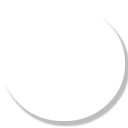
We will place this image underneath the mask image thus resulting in a border/shadow effect. This is important for
appearance since the source image is downloaded from Facebook/Google etc. and might have a color clash with the
toolbar. That way we guarantee that the border will fit in with the toolbar.
Lastly we add the image that will be placed in the toolbar area social-chat-tutorial-image-top.jpg:
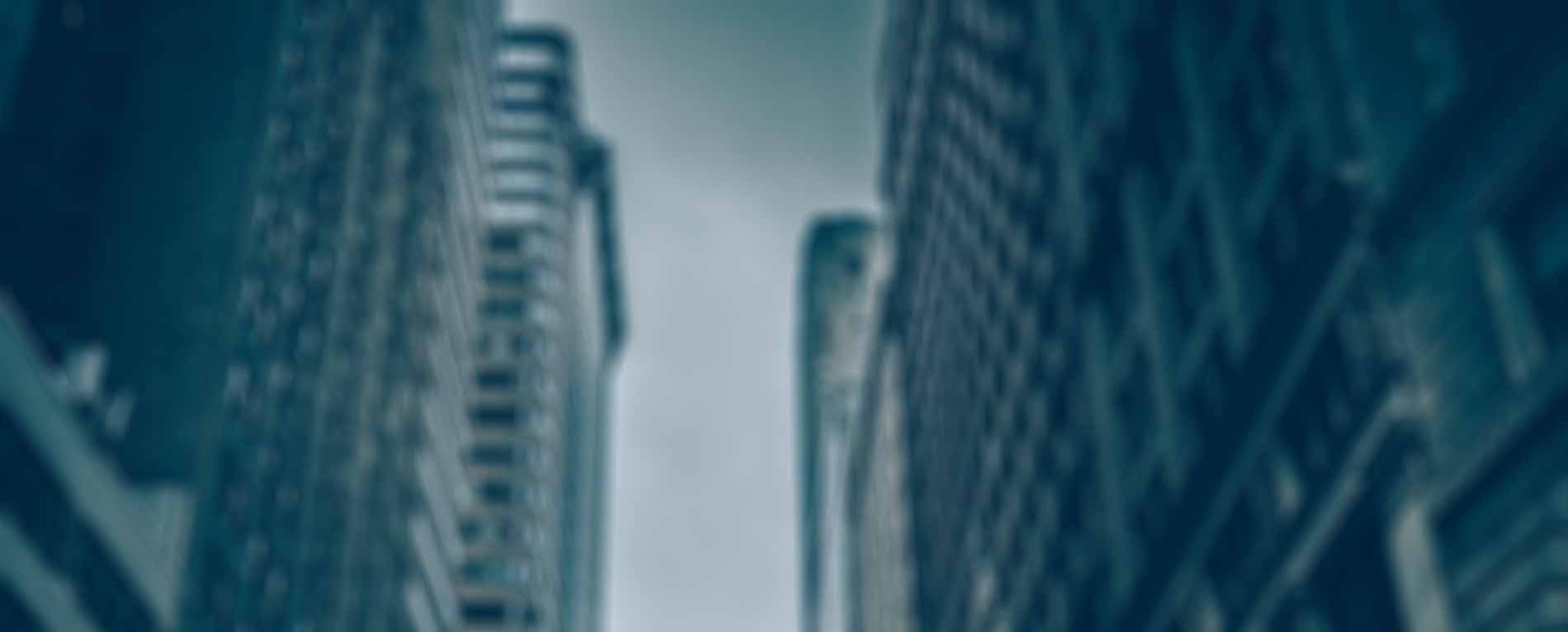
Now that all the images are in place we need to add some UIID’s into the theme to support the additional components
we will use, first we start with the LargeIconFont UIID which is very similar to the IconFont UIID we introduced the
last time around, but it doesn’t override the foreground color and is sized at 4mm. This icon font is used in the body
of the application so we want it to use the default colors so it will integrate properly, otherwise the white foreground
of the standard icon font might vanish.
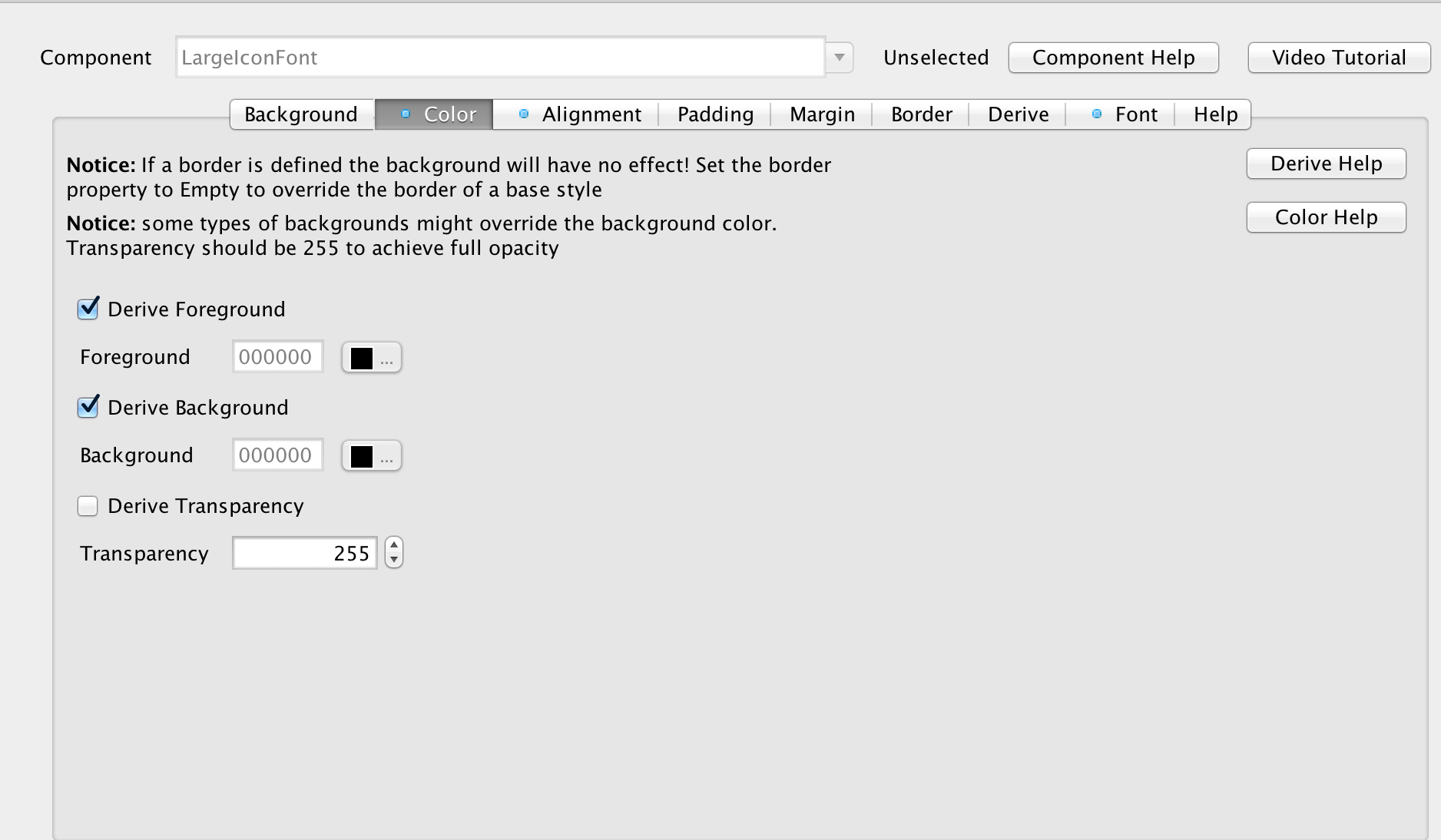
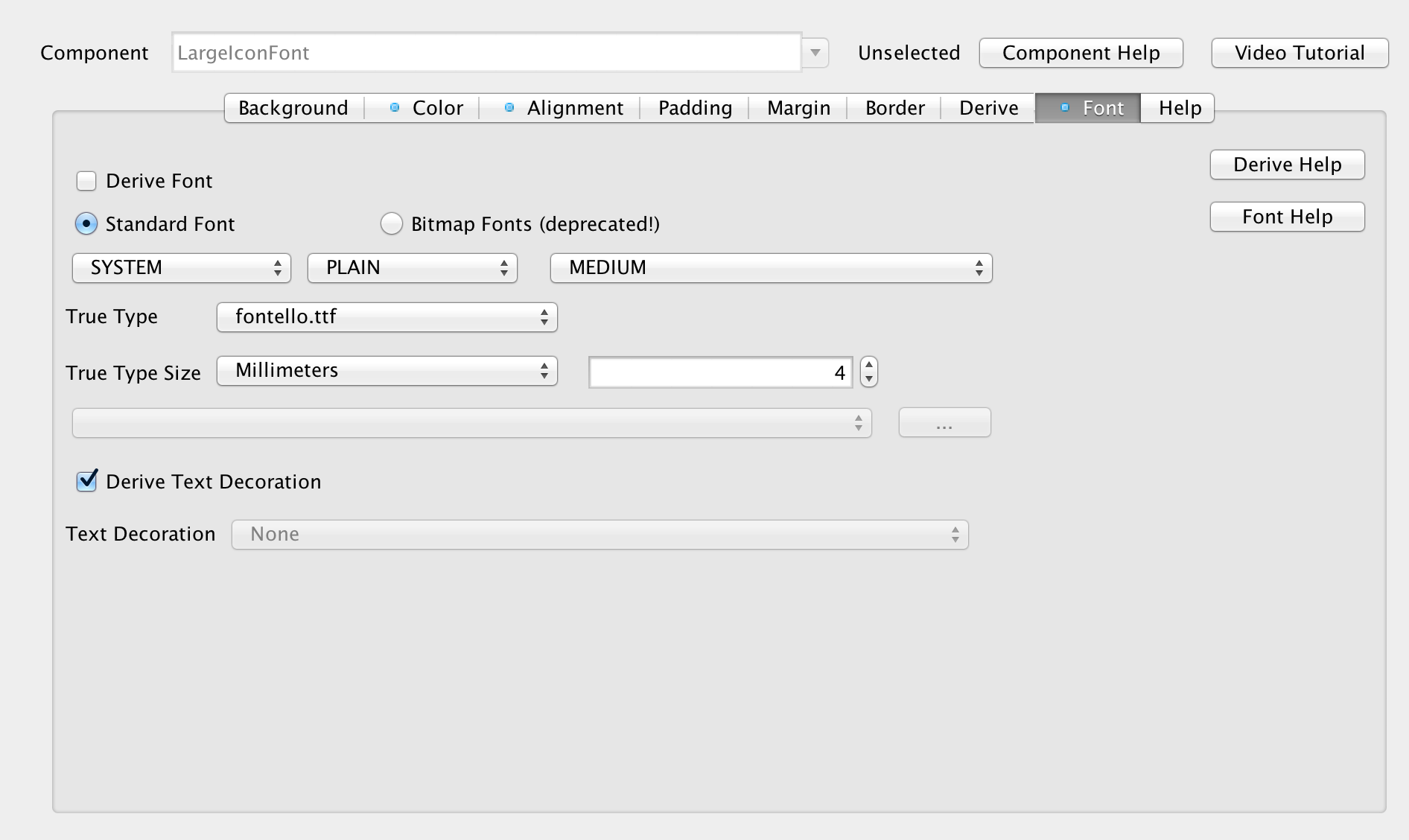
We’ll also add the rounded-border image as a UIID that we can apply to the actual image later by adding a UserImage
UIID and setting the background image to rounded-border.png and the background behavior to scaled to fit. We
also need to set the transparency to 0 to make sure that the style is transparent.
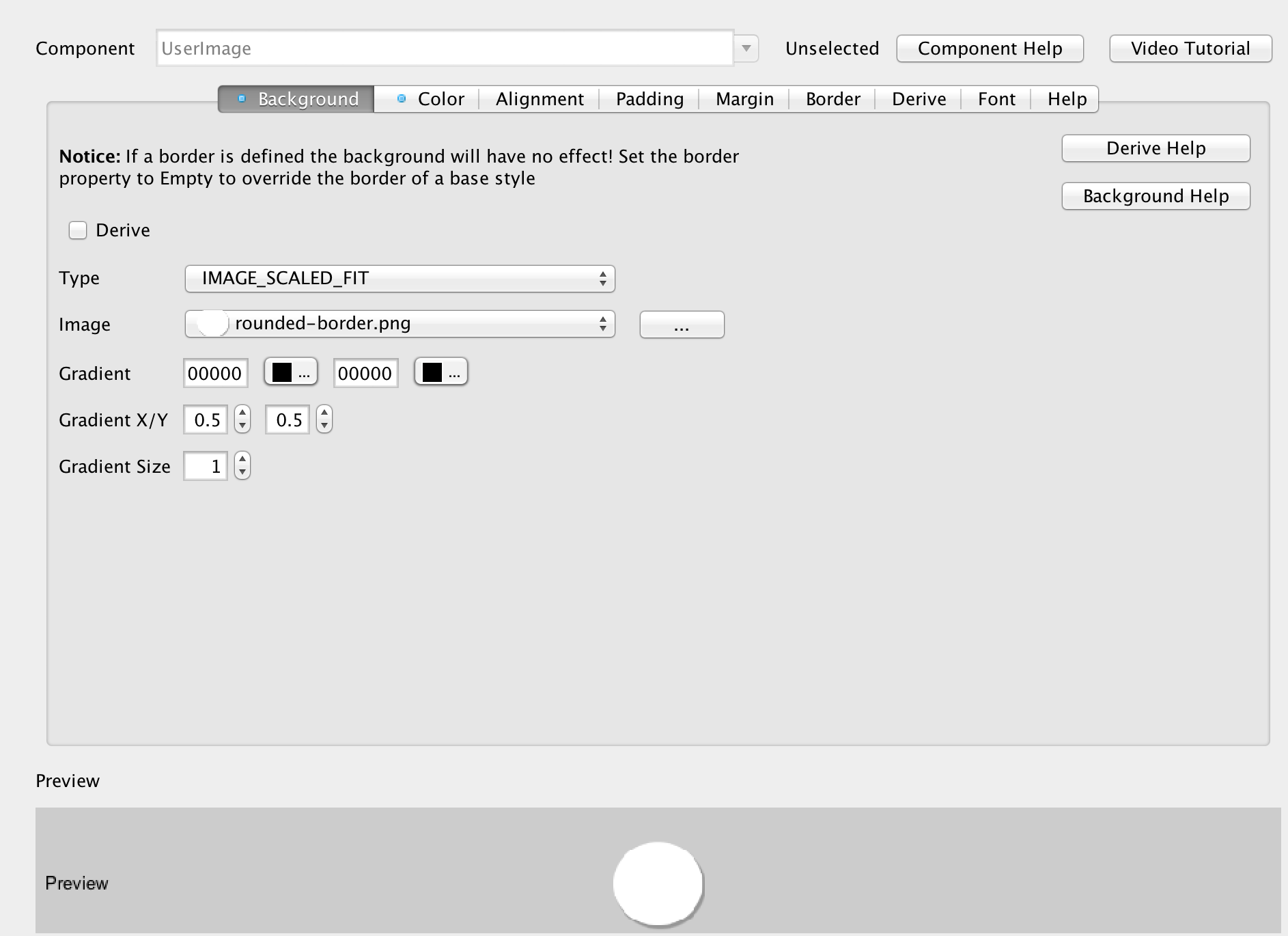
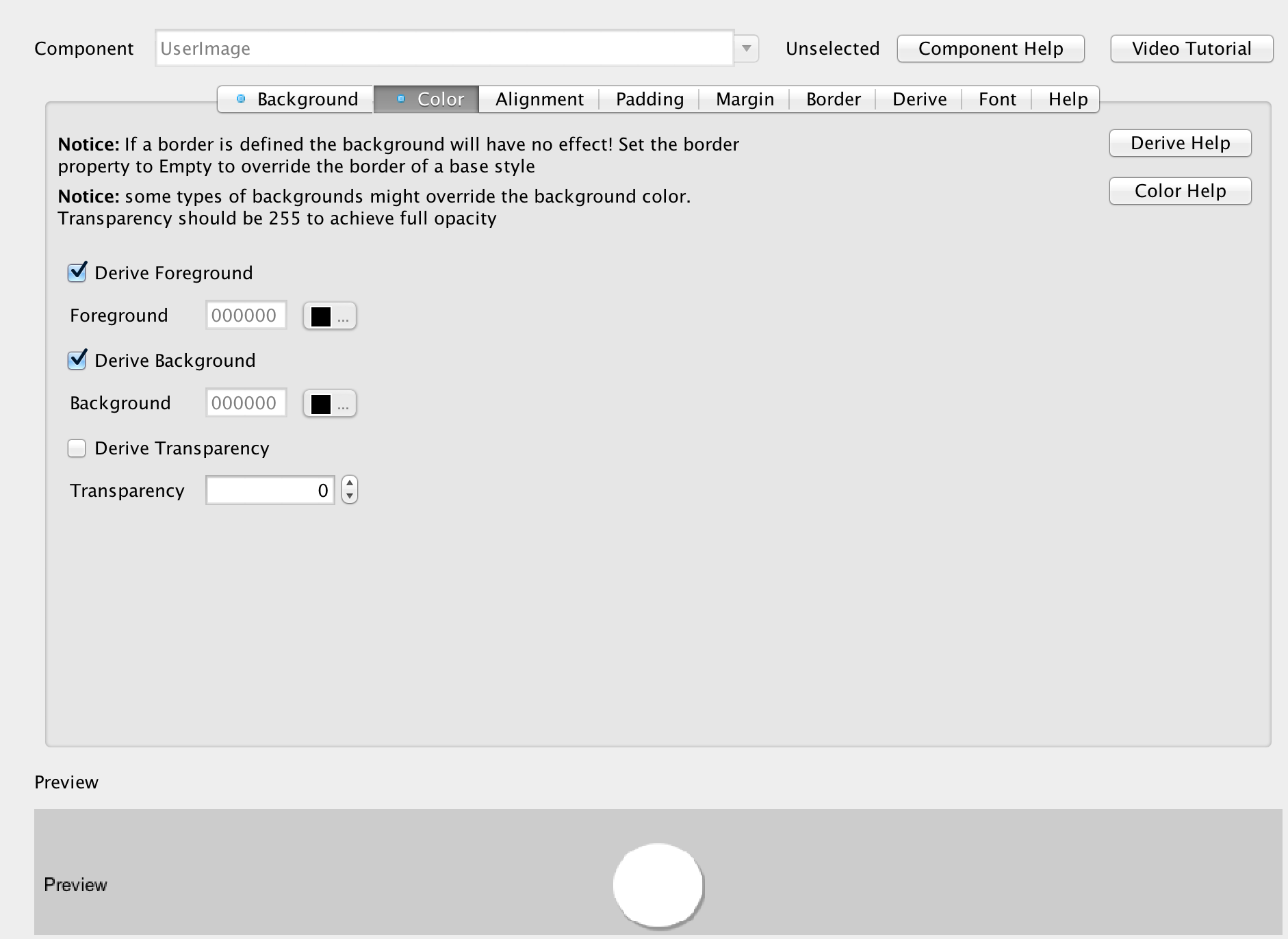
We also want to make the TitleArea more controllable thru opacity. Currently its defined as an
image border which is problematic so we will change the border to be “Empty”, define the background color to
5bc8fb and set the transparency to 255 which will give the same effect but allow us more control in the code.
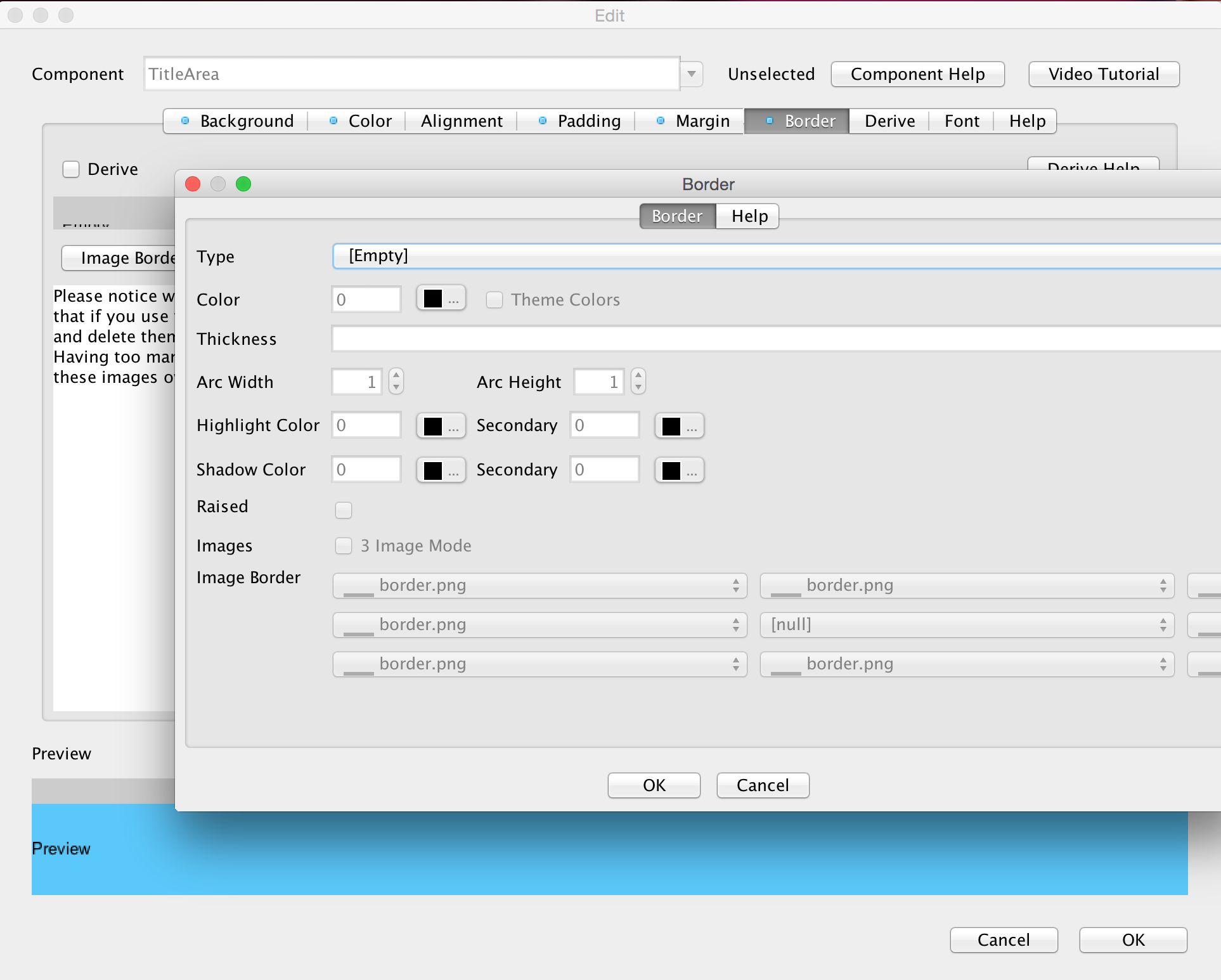
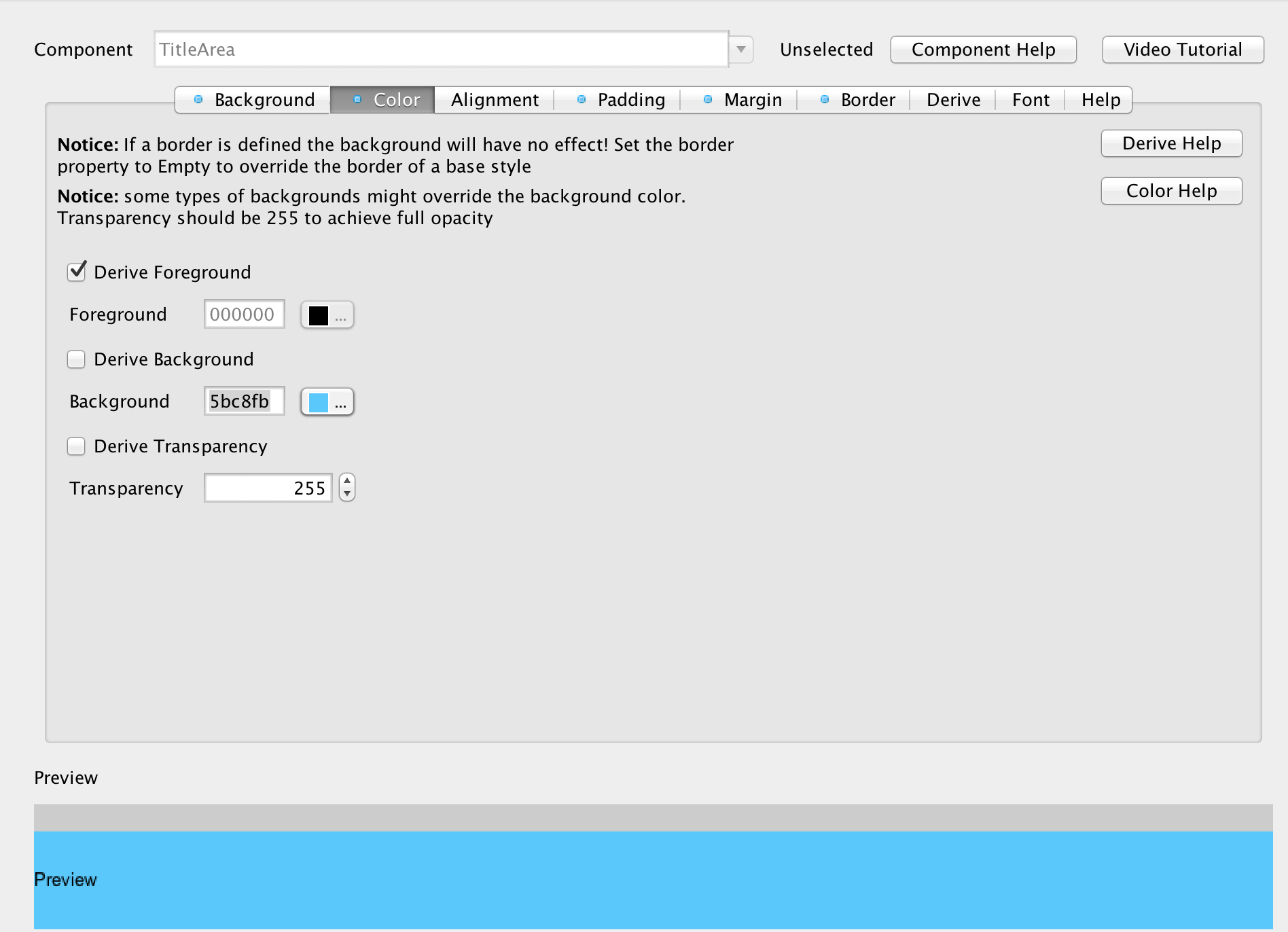
And finally MultiButton’s don’t have a clickable state in the default theme so we need to update their selected state which will provide us with a click effect.
to have 255 transparency (opaque) and have the background color `5bc8fb
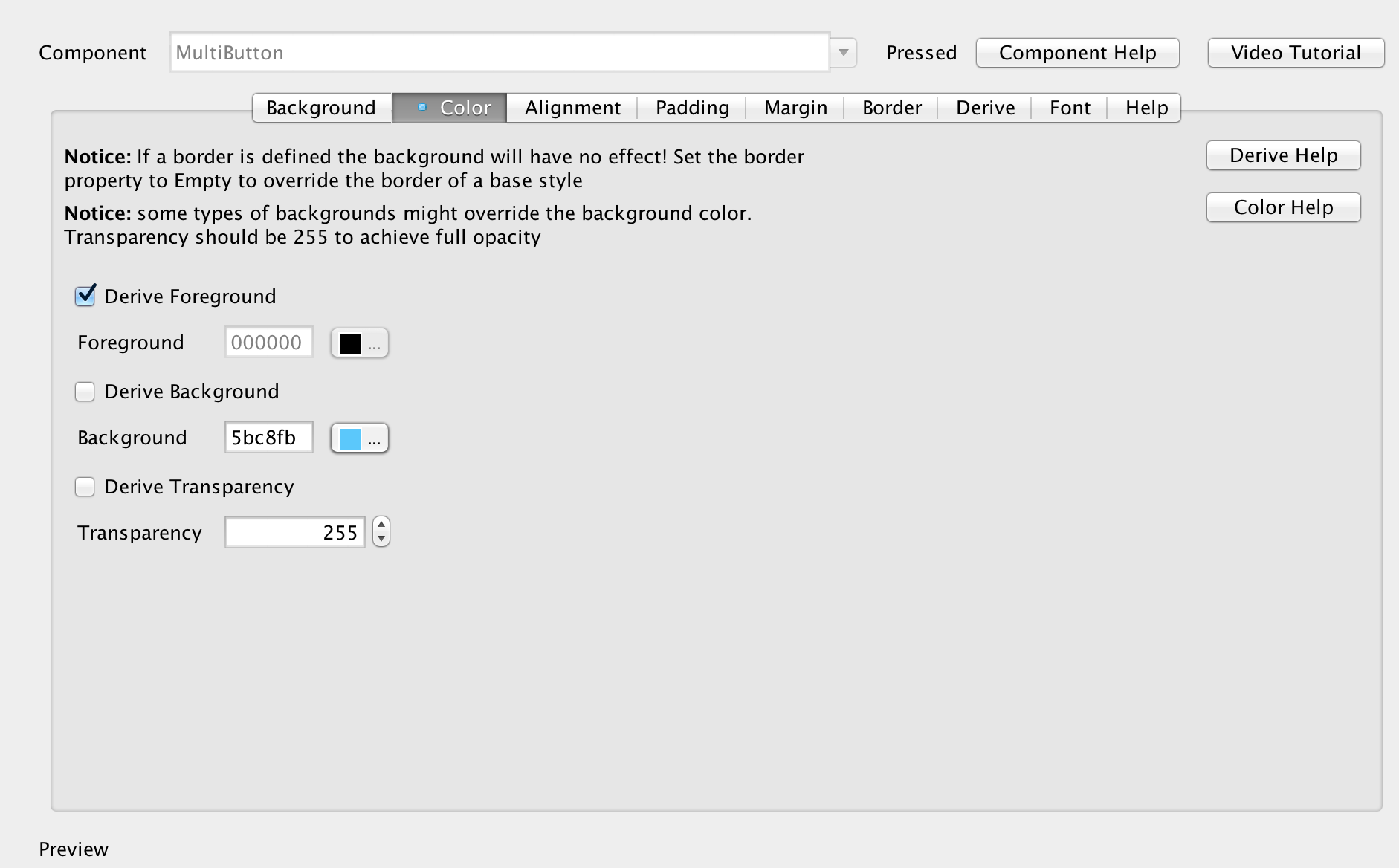
Showing The Contacts
To show the contacts we will need several new UI elements and several new class variables so first lets define the new
class members that are needed for this:
private String fullName;
private String uniqueId;
private String imageURL;
private static EncodedImage userPlaceholder;
private EncodedImage roundPlaceholder;
private Image mask;
private ContactData[] contacts;These members are defined in the main class and include images that we will use to show the individual entries and
create a “rounding” mask to make the rounded picture effect on the title bar area. We also added a variable containing
the contacts array that we can use later in the code.
To initialize these variables we’ll use the init(Object context) method, of the main class right after the theme initialization.
This code happens only once per app execution and is a great place to load/initialize things. Notice that it should
still be a relatively fast method so don’t do heavy processing there otherwise app launch might be slowed down and the
OS might kill your unresponsive app.
Style iconFontStyle = UIManager.getInstance().getComponentStyle("LargeIconFont");
iconFontStyle.setBgTransparency(255);
FontImage fnt = FontImage.create(" ue80f ", iconFontStyle);
userPlaceholder = fnt.toEncodedImage();
mask = theme.getImage("rounded-mask.png");
roundPlaceholder = EncodedImage.createFromImage(userPlaceholder.scaled(mask.getWidth(), mask.getHeight()).applyMask(mask.createMask()), false);
fullName = Preferences.get("fullName", null);
uniqueId = Preferences.get("uniqueId", null);
imageURL = Preferences.get("imageURL", null);We are doing several interesting things here, we are defining the icon style to use the LargeIconFont UIID which
allows us to create a scalable placeholder image. This is then used for two purposes in the code, placeholder for
pictures of our contacts (before the image is downloaded by URLImage) and for “my picture” (currently logged in user)
in the title area. In the “my picture” case it will be rounded using the rounded-mask image mentioned above.
This line is pretty complex so lets break it down a bit:
roundPlaceholder = EncodedImage.createFromImage(userPlaceholder.scaled(mask.getWidth(), mask.getHeight()).applyMask(mask.createMask()), false);What we do here is several different things, userPlaceholder.scaled(mask.getWidth(), mask.getHeight()) takes the
userPlaceholder and makes sure it matches the size of the mask perfectly. If it doesn’t we’ll get an exception.
We then take the mask image mask.createMask() and convert it to an internal representation. You might
recall from above that the mask image is this:

So the createMask method extracts these pixels and converts them to an internal representation that we can
later apply to an arbitrary image. This is a slightly expensive operation so we don’t recommend doing it often.
We then take the scaled image and apply the newly created mask onto the scaled image which generates
a round image with the call to applyMask.
However, we need an instance of EncodedImage and not just a regular image so we use EncodedImage.createFromImage
with the false argument (indicating the image isn’t opaque) to convert the resulting placeholder to an encoded image.
Notice that if the image is already an encoded image this method does nothing…
We need an encoded image since later in the code we will use URLImage which expects EncodedImage, the
EncodedImage is generally a more efficient way of storing images in terms of RAM and it allows us to get the image
data more effectively. It means the image PNG/JPEG data is still available… All standard/multi images returned form the resource
file are `EncodedImage’s which helps with memory utilization.
Now that everything is in place we can start with the main method that shows the UI:
void showContactsForm(UserData data) {
Form contactsForm = new Form("Contacts");
contactsForm.setLayout(new BoxLayout(BoxLayout.Y_AXIS));
// the toolbar is created into a layer on the content pane. This allows us to render behind it and leave it semi transparent
Toolbar tb = new Toolbar(true);
// we want the title area to be transparent so it won't get in the way
contactsForm.getTitleArea().setUIID("Container");
// folds the toolbar automatically as we scroll down, shows it if we scroll back up
tb.setScrollOffUponContentPane(true);
contactsForm.setToolBar(tb);
// we want the image behind the toolbar to stretch and fit the entire screen and leave no margin
Label titleLabel = new Label(" ");
Style titleLabelStyle = titleLabel.getUnselectedStyle();
titleLabelStyle.setBgImage(theme.getImage("social-chat-tutorial-image-top.jpg"));
titleLabelStyle.setBackgroundType(Style.BACKGROUND_IMAGE_SCALED_FILL);
titleLabelStyle.setPadding(tb.getPreferredH(), tb.getPreferredH(), tb.getPreferredH(), tb.getPreferredH());
titleLabelStyle.setPaddingUnit(Style.UNIT_TYPE_PIXELS, Style.UNIT_TYPE_PIXELS, Style.UNIT_TYPE_PIXELS, Style.UNIT_TYPE_PIXELS);
titleLabelStyle.setMargin(0, 0, 0, 0);
contactsForm.addComponent(titleLabel);
// the behavior of the title is rather complex so we extract it to a separate method
tb.setTitleComponent(createTitleComponent(contactsForm));
InfiniteProgress ip = new InfiniteProgress();
contactsForm.addComponent(ip);
loadContacts(data, ip, contactsForm.getContentPane());
// creates the morph and other animations from the main form to the second form of the app
createMorphEffect(titleLabel);
contactsForm.show();
}This is a relatively big method but it delegates most of the hard work to other methods so most of the stuff done
here isn’t very complex or even interesting. Here:
contacts.getTitleArea().setUIID("Container");We just make the title area transparent (since the Container UIID is always transparent), this allows us to style
the toolbar in a rather elaborate way in the createTitleComponent method.
This code:
Label titleLabel = new Label(" ");
Style titleLabelStyle = titleLabel.getUnselectedStyle();
titleLabelStyle.setBgImage(theme.getImage("social-chat-tutorial-image-top.jpg"));
titleLabelStyle.setBackgroundType(Style.BACKGROUND_IMAGE_SCALED_FILL);
titleLabelStyle.setPadding(tb.getPreferredH(), tb.getPreferredH(), tb.getPreferredH(), tb.getPreferredH());
titleLabelStyle.setPaddingUnit(Style.UNIT_TYPE_PIXELS, Style.UNIT_TYPE_PIXELS, Style.UNIT_TYPE_PIXELS, Style.UNIT_TYPE_PIXELS);
titleLabelStyle.setMargin(0, 0, 0, 0);Initializes the image behind the title:

Notice we style it in code since we want it to be positioned in a very specific way and gain the size of the toolbar. Because
of that we use the padding from the toolbar to set the size properly. Notice that we explicitly state the padding unit otherwise
some platforms which default to millimeter padding might end up out of whack.
We can do this sort of effect in several different ways but this specific approach with the “scaled to fill” option allows
the image to adapt nicely to device orientations without losing proportionality.
There are several methods used within this block, we will go thru them from the easiest to the hardest:
private MultiButton createContactComponent(ContactData d) {
MultiButton mb = new MultiButton();
mb.putClientProperty("uid", d.uniqueId);
mb.setTextLine1(d.name);
if(d.imageUrl != null) {
mb.setIcon(URLImage.createToStorage(userPlaceholder, "userPic" + d.uniqueId, d.imageUrl, URLImage.RESIZE_SCALE_TO_FILL));
} else {
mb.setIcon(userPlaceholder);
}
mb.addActionListener((e) -> {
showChatForm(d, mb);
});
return mb;
}An entry within the contacts list is just a multi-button without much funfair, we place the uid as a client property using the
putClientProperty call. This effectively allows us to place objects into a Map that exists within a Component that
way later on in the code when the button click is handled we can invoke mb.getClientProperty("uid"); and get the unique
identifier represented by the button. That’s great for decoupling the application logic from the UI.
private void createMorphEffect(Label titleLabel) {
// animate the components out of the previous form if we are coming in from the login form
Form parent = Display.getInstance().getCurrent();
if(parent.getUIID().equals("MainForm")) {
for(Component cmp : parent.getContentPane()) {
cmp.setX(parent.getWidth());
}
// moves all the components outside of the content pane to the right while fading them out over 400ms
parent.getContentPane().animateUnlayoutAndWait(400, 0);
parent.getContentPane().removeAll();
// we can't mutate a form into a component in another form so we need to convert the background to an image and then morph that
// this is especially easy since we already removed all the components
Label dummy = new Label();
dummy.setShowEvenIfBlank(true);
dummy.setUIID("Container");
dummy.setUnselectedStyle(new Style(parent.getUnselectedStyle()));
parent.setUIID("Form");
// special case to remove status bar on iOS 7
parent.getTitleArea().removeAll();
parent.setLayout(new BorderLayout());
parent.addComponent(BorderLayout.CENTER, dummy);
parent.revalidate();
// animate the main panel to the new location at the top title area of the screen
dummy.setName("fullScreen");
titleLabel.setName("titleImage");
parent.setTransitionOutAnimator(MorphTransition.create(1100).morph("fullScreen", "titleImage"));
}
}The morph effect shows several effects when leaving the main form. Notice that it only applies when the main
UI is the source of the transition, which makes sense for most cases. E.g. we will have a different effect when
going back into the contacts form from a chat…
We are showing two distinct effects here, in the first we animate the buttons outside of the screen, we do this by
placing them in their end location (outside of the screen to the right) then invoking the animateUnlayoutAndWait
which is the opposite of animateLayoutAndWait. Its designed to show exit animations like this and effectively
returns the components to their proper layout positions then animates them out while optionally fading them.
Once the components are gone we remove them and then move the image into one big label and turn the UIID
of the form to a standard form. This is necessary for the morph transition which can only morph elements and not
the form itself. Normally this “trick” would work seamlessly but on iOS we have a StatusBar UIID at the top of the form
to push the application downwards and allow us to see the content of the status bar (battery etc.). A small hack
allows us to temporarily remove that component if it exists and prevents a “bounce” in the transition.
Next we name the source/destination components for the morph transition and set it to the parent form. That’s
it, the morph transition does the rest of the work of animating the components into one another.
The title area of the form is a standard Toolbar, though instead of using a standard title we used a custom component
comprised of layers to create the special effect. The Toolbar still folds automatically as we scroll and provides
all the standard effects. It also has a cool search feature that we will discuss in the next section.
private Component createTitleComponent(Form parent) {
// we want the toolbar to be completely transparent, since we created it on the layered pane (using the true
// argument in the constructor) it will flow in the UI
parent.getToolbar().setUIID("Container");
// we create 3 layers within the title, the region contains all the layers, the encspsulate includes the "me image"
// which we want to protrude under the title area layer
Container titleRegion = new Container(new LayeredLayout());
Container titleEncapsulate = new Container(new BorderLayout());
Container titleArea = new Container(new BorderLayout());
// since the Toolbar is now transparent we assign the title area UIID to one of the layers within and the look
// is preserved, we make it translucent though so we can see what's underneath
titleArea.setUIID("TitleArea");
titleArea.getUnselectedStyle().setBgTransparency(128);
// We customize the title completely using a component, the "title" is just a label with the Title UIID
Label title = new Label(parent.getTitle());
title.setUIID("Title");
titleArea.addComponent(BorderLayout.CENTER, title);
// the search button allows us to search a large list of contacts rather easily
Button search = createSearchButton(parent, title, titleArea, titleRegion);
// we package everything in a container so we can replace the title area with a search button as needed
Container cnt = new Container(new BoxLayout(BoxLayout.X_AXIS));
titleArea.addComponent(BorderLayout.EAST, cnt);
cnt.addComponent(search);
// this is the Me picture that protrudes downwards. We use a placeholder which is then replace by the URLImage
// with the actual image. Notice that createMaskAdapter allows us to not just scale the image but also apply
// a mask to it...
Label me = new Label(URLImage.createToStorage(roundPlaceholder, "userImage", imageURL, URLImage.createMaskAdapter(mask)));
me.setUIID("UserImage");
// the search icon and the "me" image are on two separate layers so we use a "dummy" component that we
// place in the search container to space it to the side and leave room for the "me" image
Label spacer = new Label(" ");
Container.setSameWidth(spacer, me);
cnt.addComponent(spacer);
Container iconLayer = new Container(new BorderLayout());
titleEncapsulate.addComponent(BorderLayout.NORTH, titleArea);
titleRegion.addComponent(titleEncapsulate);
titleRegion.addComponent(iconLayer);
iconLayer.addComponent(BorderLayout.EAST, me);
return titleRegion;
}The search button encapsulates a lot of functionality, effectively it replaces the title with a TextField that allows
us to type in a contact name. The cool part is the way in which we filter down the contacts to find the right entry
this is done using a data change listener and hiding the irrelevant entries dynamically.
You can see this animation in action in this short video:
All of this functionality is embedded directly into the code that creates the search button:
private Button createSearchButton(Form parent, Label title, Container titleArea, Container titleRegion) {
// we want the search feature to be based on the title style so it will "fit" but we need it to use the font defined
// by the icon font UIID so we merge both
Style s = new Style(title.getUnselectedStyle());
Style iconFontStyle = UIManager.getInstance().getComponentStyle("IconFont");
s.setFont(iconFontStyle.getFont().derive(s.getFont().getHeight(), Font.STYLE_PLAIN));
FontImage searchIcon = FontImage.create(" ue806 ", s);
FontImage cancelIcon = FontImage.create(" ue81e ", s);
// this is the actual search button, but we don't want it to have a border...
Button search = new Button(searchIcon);
search.setUIID("Label");
// the search box will be placed in the title area so we can type right into it. We make it look like a title but
// explicitly align it to the left for cases such as iOS where the title is centered by default
TextField searchBox = new TextField();
searchBox.setUIID("Title");
searchBox.getUnselectedStyle().setAlignment(Component.LEFT);
searchBox.getSelectedStyle().setAlignment(Component.LEFT);
// the data change listener allows us to animate the data on every key press into the field
searchBox.addDataChangeListener((type, index) -> {
String text = searchBox.getText().toLowerCase();
if(text.length() > 0) {
Dimension hidden = new Dimension(0, 0);
// iterates over the components, if a component matches its set to visible and its size is kept as default
// otherwise the component is hidden and set to occupy no space.
for(Component cmp : parent.getContentPane()) {
if(cmp instanceof MultiButton) {
String l1 = ((MultiButton)cmp).getTextLine1();
if(l1.toLowerCase().indexOf(text) > -1) {
cmp.setPreferredSize(null);
cmp.setVisible(true);
} else {
cmp.setPreferredSize(hidden);
cmp.setVisible(false);
}
}
}
} else {
// no search string, show all the components by resetting the preferred size to default (thru null) and making them visible
for(Component cmp : parent.getContentPane()) {
cmp.setPreferredSize(null);
cmp.setVisible(true);
}
}
// update the UI with an animation effect
parent.getContentPane().animateLayout(200);
});
// the action event is invoked when the button is pressed, this can have 2 separate states: during search/before search
search.addActionListener((e) -> {
if(search.getIcon() == searchIcon) {
// Starts the search operation by replacing the title with a text field and launching the native editing
search.setIcon(cancelIcon);
titleArea.replaceAndWait(title, searchBox, CommonTransitions.createCover(CommonTransitions.SLIDE_VERTICAL, true, 400));
titleRegion.revalidate();
Display.getInstance().editString(searchBox, searchBox.getMaxSize(), searchBox.getConstraint(), "");
} else {
// if we are currently searching then cancel the search, return all items to visible and restore everything
search.setIcon(searchIcon);
for(Component cmp : parent.getContentPane()) {
cmp.setPreferredSize(null);
cmp.setVisible(true);
}
parent.getContentPane().animateLayoutAndWait(200);
search.setEnabled(true);
search.setVisible(true);
titleArea.replaceAndWait(searchBox, title, CommonTransitions.createCover(CommonTransitions.SLIDE_VERTICAL, true, 400));
}
});
return search;
}That’s a bit of a large method but its functionality is relatively simple.
Last but not least this is the method that actually loads the contacts into place:
private void loadContacts(UserData data, InfiniteProgress ip, Container contactsContainer) {
// we sort the contacts by name which is pretty concise code thanks to Java 8 lambdas
Display.getInstance().scheduleBackgroundTask(() -> {
contacts = data.getContacts();
CaseInsensitiveOrder co = new CaseInsensitiveOrder();
Arrays.sort(contacts, (ContactData o1, ContactData o2) -> {
return co.compare(o1.name, o2.name);
});
Display.getInstance().callSerially(() -> {
if(recentContacts != null && recentContacts.size() > 0) {
Label recentHeader = new Label("Recent");
recentHeader.setUIID("ContactsHeader");
contactsContainer.addComponent(recentHeader);
for(String cont : recentContacts) {
ContactData d = getContactById(cont);
contactsContainer.addComponent(createContactComponent(d));
}
Label allHeader = new Label("All Contacts");
allHeader.setUIID("ContactsHeader");
contactsContainer.addComponent(allHeader);
}
contactsContainer.removeComponent(ip);
for(ContactData d : contacts) {
contactsContainer.addComponent(createContactComponent(d));
}
contactsContainer.revalidate();
});
});
}There are several interesting things going on here.
-
We start by fetching and sorting the contacts in a low priority thread. We can just do something like
new Thread()
which would be pretty similar butscheduleBackgroundTaskrecycles an existing thread which is slightly more
efficient. -
We then return to the EDT using
callSeriallyto add the components to the UI where we create an entry for
every component and revalidate to layout the UI -
There is some code here for a “recent” entry which should priorities the contacts I’ve contacted recently, its
functionality that’s added in the local code base but isn’t fully implemented.
Next time we’ll discuss the chat UI.
Note: The original post neglected to include the body of the loadContacts method.
Other Posts In This Series
This is a multi-part series of posts including the following parts:
You can check out the final source code of this tutorial here.





10 Comments
I like this,i wish i could do this all day.Questions will come soon
For the image placeholder, will it be possible to use fullName’s first character in Font Icon? For example, My name Diamond having “D” as the placeholder image just in case user doesn’t have a profile pic.
“A small hack allows us to temporarily remove that component if it exists and prevents a “bounce” in the transition.” Are you referring to iOS status bar? If yes, any idea on how to temporarily hide the status bar?
Sure. You can do this dynamically e.g. Map<character, encodedimage=””> mm =…; Then use an Image.create(int, int, int) and get the graphics from it to draw the character on it. Cache it in the map so you don’t have to do this all the time…
Yes, the status bar. You can hide the entire title area by using getTitleArea().setPreferredSize(new Dimension(0, 0))); That will also hide the status bar.
This is great! Thanks so much.
shai am still desprately waiting for next series
this is a great tutorial series! thanks somuch
I want to ask about chat group room is supported with codename one, or one chat per application without allowing user to create new group and chatting.
This specific demo is for 1 on 1 conversations but the platform has no such restrictions. Check out this post covering a 3rd party who built a pretty nice looking whatsapp clone using Codename One: [https://www.codenameone.com…](https://www.codenameone.com/blog/featured-app-jat-communication.html)
A simple question that is not related to the tutorial itself: how did you record the small video of the app? Thank you
With Android it’s really easy. My device has a screen capture app that’s shipped by the vendor and allows recording video so this is really trivial (it’s an OPO with the original cyanogen so probably not applicable).
But all modern android devices allow you to capture video via ADB see [https://developer.android.c…](https://developer.android.com/studio/command-line/adb.html#screenrecord)
For iOS I used to use Reflection but those a*holes essentially want to charge again for Relection II after I paid for 1. Turns out you don’t need that at all and it’s a huge waste!
On a Mac just connect the device and launch Quick Time. Then launch recording from quicktime and you will literally see the device screen and you can record everything then cut the parts of the video you want/don’t want. Very cool and useful!